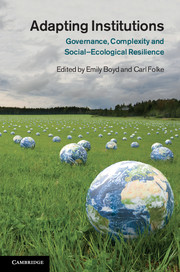Book contents
- Frontmatter
- Contents
- Illustrations
- Contributors
- Foreword
- Acknowledgements
- Acronyms and abbreviations
- 1 Adapting institutions, adaptive governance and complexity: an introduction
- Part I Adapting local institutions, networks, leadership and learning
- 2 Knowledge, social networks and leadership: setting the stage for the development of adaptive institutions?
- 3 Adaptive capacity of local indigenous institutions: the case of the taboo forests of southern Madagascar
- 4 Adapting to change: tracing farmers’ responses to disturbances in irrigation systems in Nepal
- 5 Creating incentives for increased public engagement in ecosystem management through urban commons
- Part II Adapting and governing public institutions for uncertainty and complexity
- Part III Adapting multi-level institutions to environmental crisis
- Index
- References
5 - Creating incentives for increased public engagement in ecosystem management through urban commons
from Part I - Adapting local institutions, networks, leadership and learning
Published online by Cambridge University Press: 05 November 2011
- Frontmatter
- Contents
- Illustrations
- Contributors
- Foreword
- Acknowledgements
- Acronyms and abbreviations
- 1 Adapting institutions, adaptive governance and complexity: an introduction
- Part I Adapting local institutions, networks, leadership and learning
- 2 Knowledge, social networks and leadership: setting the stage for the development of adaptive institutions?
- 3 Adaptive capacity of local indigenous institutions: the case of the taboo forests of southern Madagascar
- 4 Adapting to change: tracing farmers’ responses to disturbances in irrigation systems in Nepal
- 5 Creating incentives for increased public engagement in ecosystem management through urban commons
- Part II Adapting and governing public institutions for uncertainty and complexity
- Part III Adapting multi-level institutions to environmental crisis
- Index
- References
Summary
The ‘commoners’ of the past are the ‘stakeholders’ of the present and future.
Bonnie J. McCay (2000)Introduction
Over half the world’s population currently lives in urban areas; by 2030, nearly five billion people are expected to live in cities (Ash et al. 2008). Between 2010 and 2030, the amount of the built mass on the earth is predicted to double, creating ever-greater demands on the services that nearby and distant ecosystems provide (Grimm et al. 2008). With a greater proportion of humans living in metropolitan areas, urban ecosystems will experience increased land-use and land-cover change. Currently, urbanisation endangers more species and is more geographically ubiquitous than any other human activity; urban sprawl is rapidly transforming critical habitats of global value, such as the Atlantic Forest Region of Brazil, the Cape of South Africa and coastal Central America (Elmqvist et al. 2008). Urbanisation leads not only to increased homogenisation of fauna and flora (McKinney 2002) but also to an impoverished biology in metropolitan areas, which arguably serves as a constant reminder of the presumed unimportance of biodiversity and so may contribute to ‘environmental generational amnesia’ among the greater public (Miller 2005).
To gain the much-needed broad-based public support for a sustainable use of ecosystems, both within and outside cities, the places where people live and work need to offer opportunities for meaningful interactions with functioning ecosystems (Rosenzweig 2003, Miller 2005, Andersson et al. 2007, Colding 2007). In this respect, and to help mitigate the growing disconnection of urban residents from nature (Pyle 1978, 1993), the dynamics of property rights determining human relationships to land can have powerful ramifications and be worthy of scholarly analysis to provide propositions about both the manner in which land ownership in cities evolves (Webster 2003) and its potential outcomes, such as the provision of the ecosystem services critical to human well-being (Daily 1997, Millennium Ecosystem Assessment 2005). It is increasingly recognised that today’s institutions match current changes in ecosystems and their dynamics poorly (Millennium Ecosystem Assessment 2005, Folke et al. 2007).
Information
- Type
- Chapter
- Information
- Adapting InstitutionsGovernance, Complexity and Social-Ecological Resilience, pp. 101 - 124Publisher: Cambridge University PressPrint publication year: 2011
References
Accessibility standard: Unknown
Why this information is here
This section outlines the accessibility features of this content - including support for screen readers, full keyboard navigation and high-contrast display options. This may not be relevant for you.Accessibility Information
- 8
- Cited by
